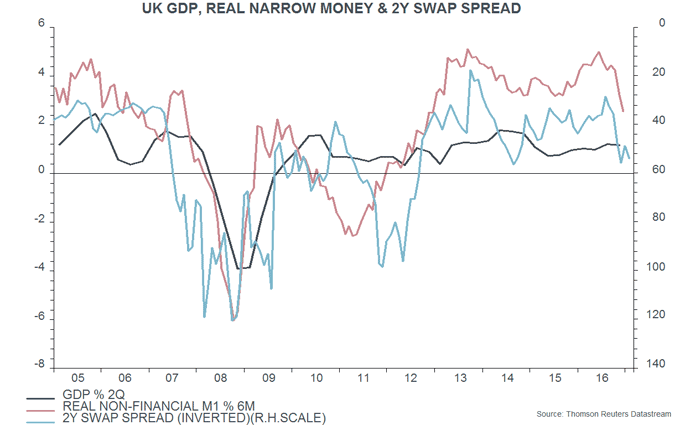UK December data for industrial / construction output and services turnover suggest that fourth-quarter GDP growth will be revised up to 0.7%. Investors should be wary of extrapolating current economic strength, since monetary trends have weakened recently.
The Office for National Statistics (ONS) today reported that industrial and construction output rose by 1.1% and 1.8% respectively between November and December – above estimated gains of 0.6% and 1.0% incorporated in its preliminary estimate that GDP grew by 0.6% last quarter. More importantly, the services turnover survey – also released today but ignored by most economists – suggests that output in that sector increased further in December despite a previously-reported 1.9% drop in retail sales / output; the ONS had assumed that services output would be stable at November’s level. If so, fourth-quarter GDP growth is likely to be raised to 0.7% – revised figures will be released on 22 February. Growth excluding the oil and gas sector could rise to 0.8% (0.7% currently).
The February Inflation Report projected that GDP growth would be unrevised at 0.6% in the fourth quarter and fall to 0.5% in the first quarter. Based on current evidence, the level of GDP in December may have been 0.3-0.4% above the fourth-quarter average, suggesting upside risk to the Bank’s first-quarter growth forecast.
An upward revision in fourth-quarter growth to 0.7% would imply that GDP rose by 1.3%, or 2.6% annualised, in the third and fourth quarters combined – the largest two-quarter gain since the fourth quarter of 2014. A pick-up into early 2017 had been predicted by a rise in six-month real narrow money expansion to a peak in June 2016 – see chart. It is likely that second-half GDP growth would have been significantly stronger but for the Brexit vote – see previous post.
Real narrow money growth remained solid through October but weakened in November / December, suggesting that the economy will retain momentum through the first half of 2017 but slow in the summer. A cautionary signal is also being given by a recent widening of the two-year swap spread, which – as in the US – has been inversely correlated with future economic growth in recent years.